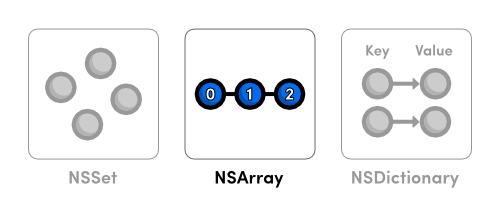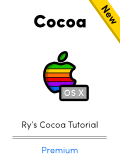You’re reading Ry’s Objective-C Tutorial → Data Types |
NSArray
NSArray is Objective-C’s general-purpose array type. It
represents an ordered collection of objects, and it provides a high-level
interface for sorting and otherwise manipulating lists of data. Arrays
aren’t as efficient at membership checking as sets, but the trade-off is that they reliably record the
order of their elements.

Like NSSet, NSArray is immutable, so you cannot
dynamically add or remove items. Its mutable counterpart,
NSMutableArray, is discussed in the second part of this module.
Creating Arrays
Immutable arrays can be defined as literals using the @[]
syntax. This was added relatively late in the evolution of the language (Xcode
4.4), so you’re likely to encounter the more verbose
arrayWithObjects: factory method at some point in your Objective-C
career. Both options are included below.
NSArray*germanMakes=@[@"Mercedes-Benz",@"BMW",@"Porsche",@"Opel",@"Volkswagen",@"Audi"];NSArray*ukMakes=[NSArrayarrayWithObjects:@"Aston Martin",@"Lotus",@"Jaguar",@"Bentley",nil];NSLog(@"First german make: %@",germanMakes[0]);NSLog(@"First U.K. make: %@",[ukMakesobjectAtIndex:0]);
As you can see, individual items can be accessed through the square-bracket
subscripting syntax (germanMakes[0]) or the
objectAtIndex: method. Prior to Xcode 4.4,
objectAtIndex: was the standard way to access array elements.
Enumerating Arrays
Fast-enumeration is the most efficient way to iterate over an
NSArray, and its contents are guaranteed to appear in the correct
order. It’s also possible to use the count method with a
traditional for-loop to step through each element in the array:
NSArray*germanMakes=@[@"Mercedes-Benz",@"BMW",@"Porsche",@"Opel",@"Volkswagen",@"Audi"];// With fast-enumerationfor(NSString*itemingermanMakes){NSLog(@"%@",item);}// With a traditional for loopfor(inti=0;i<[germanMakescount];i++){NSLog(@"%d: %@",i,germanMakes[i]);}
If you’re fond of blocks, you can use the
enumerateObjectsUsingBlock: method. It works the same as NSSet’s version,
except the index of each item is also passed to the block, so its signature
looks like ^(id obj, NSUInteger idx, BOOL *stop). And of course,
the objects are passed to the block in the same order as they appear in the
array.
[germanMakesenumerateObjectsUsingBlock:^(idobj,NSUIntegeridx,BOOL*stop){NSLog(@"%ld: %@",idx,obj);}];
Comparing Arrays
Arrays can be compared for equality with the aptly named
isEqualToArray: method, which returns YES when both
arrays have the same number of elements and every pair pass an
isEqual: comparison. NSArray does not offer the
same subset and intersection comparisons as NSSet.
NSArray*germanMakes=@[@"Mercedes-Benz",@"BMW",@"Porsche",@"Opel",@"Volkswagen",@"Audi"];NSArray*sameGermanMakes=[NSArrayarrayWithObjects:@"Mercedes-Benz",@"BMW",@"Porsche",@"Opel",@"Volkswagen",@"Audi",nil];if([germanMakesisEqualToArray:sameGermanMakes]){NSLog(@"Oh good, literal arrays are the same as NSArrays");}
Membership Checking
NSArray provides similar membership checking utilities to
NSSet. The containsObject: method works the exact
same (it returns YES if the object is in the array,
NO otherwise), but instead of member:,
NSArray uses indexOfObject:. This either returns the
index of the first occurrence of the requested object or
NSNotFound if it’s not in the array.
NSArray*germanMakes=@[@"Mercedes-Benz",@"BMW",@"Porsche",@"Opel",@"Volkswagen",@"Audi"];// BOOL checkingif([germanMakescontainsObject:@"BMW"]){NSLog(@"BMW is a German auto maker");}// Index checkingNSUIntegerindex=[germanMakesindexOfObject:@"BMW"];if(index==NSNotFound){NSLog(@"Well that's not quite right...");}else{NSLog(@"BMW is a German auto maker and is at index %ld",index);}
Since arrays can contain more than one reference to the same object,
it’s possible that the first occurrence isn’t the only one. To find
other occurrences, you can use the related indexOfObject:inRange:
method.
Remember that sets are more efficient for membership checking, so if you’re querying against a large collection of objects, you should probably be using a set instead of an array.
Sorting Arrays
Sorting is one of the main advantages of arrays. One of the most flexible
ways to sort an array is with the sortedArrayUsingComparator:
method. This accepts an ^NSComparisonResult(id obj1, id obj2)
block, which should return one of the following enumerators depending on the
relationship between obj1 and obj2:
| Return Value | Description |
|---|---|
NSOrderedAscending |
obj1 comes before obj2
|
NSOrderedSame |
obj1 and obj2 have no order |
NSOrderedDescending |
obj1 comes after obj2
|
The following example sorts a list of car manufacturers based on how long their name is, from shortest to longest.
NSArray*germanMakes=@[@"Mercedes-Benz",@"BMW",@"Porsche",@"Opel",@"Volkswagen",@"Audi"];NSArray*sortedMakes=[germanMakessortedArrayUsingComparator:^NSComparisonResult(idobj1,idobj2){if([obj1length]<[obj2length]){returnNSOrderedAscending;}elseif([obj1length]>[obj2length]){returnNSOrderedDescending;}else{returnNSOrderedSame;}}];NSLog(@"%@",sortedMakes);
Like NSSet, NSArray is immutable, so the sorted
array is actually a new array, though it still references the same
elements as the original array (this is the same behavior as
NSSet).
Filtering Arrays
You can filter an array with the filteredArrayUsingPredicate:
method. A short introduction to predicates can be found in the NSSet module, and a minimal
example is included below. Just as with the sort method discussed above, this
generates a brand new array.
NSArray*germanMakes=@[@"Mercedes-Benz",@"BMW",@"Porsche",@"Opel",@"Volkswagen",@"Audi"];NSPredicate*beforeL=[NSPredicatepredicateWithBlock:^BOOL(idevaluatedObject,NSDictionary*bindings){NSComparisonResultresult=[@"L"compare:evaluatedObject];if(result==NSOrderedDescending){returnYES;}else{returnNO;}}];NSArray*makesBeforeL=[germanMakesfilteredArrayUsingPredicate:beforeL];NSLog(@"%@",makesBeforeL);// BMW, Audi
Subdividing Arrays
Subdividing an array is essentially the same as extracting substrings from
an NSString, but instead of substringWithRange:, you
use subarrayWithRange:, as shown below.
NSArray*germanMakes=@[@"Mercedes-Benz",@"BMW",@"Porsche",@"Opel",@"Volkswagen",@"Audi"];NSArray*lastTwo=[germanMakessubarrayWithRange:NSMakeRange(4,2)];NSLog(@"%@",lastTwo);// Volkswagen, Audi
Combining Arrays
Arrays can be combined via arrayByAddingObjectsFromArray:. As
with all of the other immutable methods discussed above, this returns a
new array containing all of the elements in the original array, along
with the contents of the parameter.
NSArray*germanMakes=@[@"Mercedes-Benz",@"BMW",@"Porsche",@"Opel",@"Volkswagen",@"Audi"];NSArray*ukMakes=@[@"Aston Martin",@"Lotus",@"Jaguar",@"Bentley"];NSArray*allMakes=[germanMakesarrayByAddingObjectsFromArray:ukMakes];NSLog(@"%@",allMakes);
String Conversion
The componentsJoinedByString: method concatenates each element
of the array into a string, separating them by the specified symbol(s).
NSArray*ukMakes=@[@"Aston Martin",@"Lotus",@"Jaguar",@"Bentley"];NSLog(@"%@",[ukMakescomponentsJoinedByString:@", "]);
This can be useful for regular expression generation, file path manipulation, and rudimentary CSV processing; however, if you’re doing serious work with file paths/data, you’ll probably want to look for a dedicated library.
NSMutableArray
The NSMutableArray class lets you dynamically add or remove
items from arbitrary locations in the collection. Keep in mind that it’s
slower to insert or delete elements from a mutable array than a set or a
dictionary.
Like mutable sets, mutable arrays are often used to represent the state of a
system, but the fact that NSMutableArray records the order of its
elements opens up new modeling opportunities. For instance, consider the auto
repair shop we talked about in the NSSet
module. Whereas a set can only represent the status of a collection of
automobiles, an array can record the order in which they should be fixed.
Creating Mutable Arrays
Literal arrays are always immutable, so the easiest way to create mutable
arrays is still through the arrayWithObjects: method. Be careful
to use NSMutableArray’s version of the method, not
NSArray’s. For example:
NSMutableArray*brokenCars=[NSMutableArrayarrayWithObjects:@"Audi A6",@"BMW Z3",@"Audi Quattro",@"Audi TT",nil];
You can create empty mutable arrays using the array or
arrayWithCapacity: class methods. Or, if you already have an
immutable array that you want to convert to a mutable one, you can pass it to
the arrayWithArray: class method.
Adding and Removing Objects
The two basic methods for manipulating the contents of an array are the
addObject: and removeLastObject methods. The former
adds an object to the end of the array, and the latter is pretty
self-documenting. Note that these are also useful methods for treating an
NSArray as a stack.
NSMutableArray*brokenCars=[NSMutableArrayarrayWithObjects:@"Audi A6",@"BMW Z3",@"Audi Quattro",@"Audi TT",nil];[brokenCarsaddObject:@"BMW F25"];NSLog(@"%@",brokenCars);// BMW F25 added to end[brokenCarsremoveLastObject];NSLog(@"%@",brokenCars);// BMW F25 removed from end
It’s most efficient to add or remove items at the end of an
array, but you can also insert or delete objects at arbitrary locations using
insertObject:atIndex: and removeObjectAtIndex:. Or,
if you don’t know the index of a particular object, you can use the
removeObject: method, which is really just a convenience method
for indexOfObject: followed by
removeObjectAtIndex:.
// Add BMW F25 to front[brokenCarsinsertObject:@"BMW F25"atIndex:0];// Remove BMW F25 from front[brokenCarsremoveObjectAtIndex:0];// Remove Audi Quattro[brokenCarsremoveObject:@"Audi Quattro"];
It’s also possible to replace the contents of an index with the
replaceObjectAtIndex:withObject: method, as shown below.
// Change second item to Audi Q5[brokenCarsreplaceObjectAtIndex:1withObject:@"Audi Q5"];
These are the basic methods for manipulating mutable arrays, but be sure to check out the official documentation if you need more advanced functionality.
Sorting With Descriptors
Inline sorts can be accomplished through sortUsingComparator:,
which works just like the immutable version discussed in Sorting Arrays. However, this section discusses an
alternative method for sorting arrays called NSSortDescriptor.
Sort descriptors typically result in code that is more semantic and less
redundant than block-based sorts.
The NSSortDescriptor class encapsulates all of the information
required to sort an array of dictionaries or
custom objects. This includes the property to be compared, the comparison
method, and whether the sort is ascending or descending. Once you configure a
descriptor(s), you can sort an array by passing it to the
sortUsingDescriptors: method. For example, the following snippet
sorts an array of cars by price and then by model.
NSDictionary*car1=@{@"make":@"Volkswagen",@"model":@"Golf",@"price":[NSDecimalNumberdecimalNumberWithString:@"18750.00"]};NSDictionary*car2=@{@"make":@"Volkswagen",@"model":@"Eos",@"price":[NSDecimalNumberdecimalNumberWithString:@"35820.00"]};NSDictionary*car3=@{@"make":@"Volkswagen",@"model":@"Jetta A5",@"price":[NSDecimalNumberdecimalNumberWithString:@"16675.00"]};NSDictionary*car4=@{@"make":@"Volkswagen",@"model":@"Jetta A4",@"price":[NSDecimalNumberdecimalNumberWithString:@"16675.00"]};NSMutableArray*cars=[NSMutableArrayarrayWithObjects:car1,car2,car3,car4,nil];NSSortDescriptor*priceDescriptor=[NSSortDescriptorsortDescriptorWithKey:@"price"ascending:YESselector:@selector(compare:)];NSSortDescriptor*modelDescriptor=[NSSortDescriptorsortDescriptorWithKey:@"model"ascending:YESselector:@selector(caseInsensitiveCompare:)];NSArray*descriptors=@[priceDescriptor,modelDescriptor];[carssortUsingDescriptors:descriptors];NSLog(@"%@",cars);// car4, car3, car1, car2
The descriptor’s selector is called on each key’s
value, so in the above code, we’re calling compare: on
item[@"price"] and caseInsensitiveCompare: on
item[@"model"] for each pair of items in the array.
Filtering Mutable Arrays
Filtering works the same as it does with immutable arrays, except items are
removed from the existing array instead of generating a new one, and you use
the filterUsingPredicate: method.
Enumeration Considerations
As with all mutable collections, you’re not allowed to alter it in the
middle of an enumeration. This is covered in the Enumeration Considerations
section of the NSSet module, but instead of using
allObjects for the snapshot, you can create a temporary copy of
the original array by passing it to the arrayWithArray: class
method.
 |
Be sure to check out Ry’s Cocoa Tutorial. This brand new guide is a complete walkthrough of Mac App development, and it leverages all of the Objective-C skills that we just discussed. Learn more › |
Mailing List
Sign up for my low-volume mailing list to find out when new content is released. Next up is a comprehensive Swift tutorial planned for late January.
You’ll only receive emails when new tutorials are released, and your contact information will never be shared with third parties. Click here to unsubscribe.